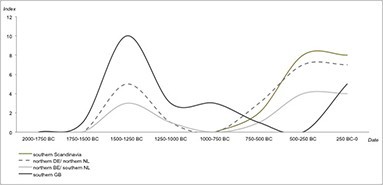Time and causality: exploring non-linear processes of prehistoric landscape change
Introduction
The recently commenced project ‘Time and causality: exploring non-linear processes of prehistoric landscape change’ aims to revise the chronological foundation of the earliest forms of landscape parcelling in southern Scandinavia from the Bronze Age to the Early Iron Age.
Archaeological data have been collected on an unprecedented scale across north-western Europe. Large-scale excavations have, in many places, revealed complex patterns in prehistoric landscape development, such as the emergence of physical enclosures of land, offering the opportunity to understand these long-term trajectories in new ways. The temporal and causal complexity of these data, however, has been only sparsely explored, and most models are based on a limited body of data with coarse chronologies and the application of linear causal reasoning. Hence, there is still little explanation for the emergence of these cultural changes. Consequently, there is a critical need to make use of large datasets in order to undertake innovative and systematic investigations of the chronological processes and culture-historical conditions of the earliest forms of landscape parcelling, and to develop non-linear models of their culture-historical causation.
The project is hosted by the School of Culture and Society, Aarhus University, and will run from 2015 to 2018. It is financed by The Danish Council for Independent Research and Sapere Aude Research Talent 1. Additional OSL samples have been made possible by the Elisabeth Munksgaard Foundation.
The project collaborators are Chris Gosden (University of Oxford), Harry Fokkens (University of Leiden), Morten Axel Pedersen (University of Copenhagen) and James Fowler (University of California, San Diego) as well as The Aarhus University network for Science and Technology in Archaeological Research (AU STAR).
Early forms of landscape enclosure
From the mid second millennium BC, large areas of north-western Europe were subject to a parcelling up of the landscape, often referred to as Celtic or co-axial fields (Figure 1). Thousands of hectares of land were enclosed by banks or fences, entailing significant transformation in the layout of the landscape. The study of the emergence and expansion of these fields has long been based on a form of thinking that emphasises linear progression; for example, arguing that parcelling was a by-product of increased resource pressure and population density, agricultural intensification or a more permanent use of the landscape. Such factors are often expected to have increased more or less steadily and continuously from the Late Neolithic to the Bronze Age and later.
Recent observations, however, indicate more complex causal and chronological relationships between local and large-scale trends (see also McGlade & van der Leeuw 1997). For example, the formation of banks is characterised by complex material biographies, sometimes accumulating over more than half a millennium (see Arnoldussen & Scheele 2014), rendering it problematic to define an exact moment of construction or archaeological visibility. Landscape parcelling also emerges earlier than previously assumed, meaning that it sometimes anticipates assumed causes. Furthermore, in a cross-regional perspective, landscape parcelling appears to emerge displaced in time, indicating that its spread across north-western Europe did not necessarily follow a linear geographic or chronological trajectory (Figure 2; Løvschal 2014a).
These observations raise a number of issues regarding previous models and their explanatory value on various geographic scales: when did these processes commence, how synchronised were they and why did they begin in the first place? These questions are vital if we wish to obtain a more nuanced, diachronic understanding of long-term cultural changes and of why the division of land became, and remains, such a pervasive feature of the landscape.
Methods and materials
The archaeological record from southern Scandinavia is particularly suitable for this project because it is well investigated and offers the opportunity to combine a broad spectrum of anthropogenic, culture-historical and environmental evidence. Since the 1930s, field systems have been systematically recorded, and significant priority has recently been given to dating and environmental sampling. The project will undertake a detailed literature survey, as well as fieldwork at five locations on the Jutland peninsula, with the intention of obtaining sequences of high-resolution radiocarbon and OSL dates from field banks.
More broadly, the project draws on an extensive unpublished database of more than 6200 sites from across north-western Europe, with evidence of landscape boundaries (Løvschal 2014b); new absolute dates for the earliest landscape parcelling will also be collated as part of the project. These data will enable a comparison between diachronic local processes and large-scale cultural trends.
The collected data will allow for a critical evaluation of established explanatory models of prehistoric landscape parcelling and their dominant causal reasoning for long-term cultural development. Furthermore, mapping the spatial and temporal diversity of parcelling across north-western Europe will provide a better understanding of why the earliest visible forms of landscape parcelling became physically instantiated, and it will allow alternatives to the traditional, linear causal explanations to be developed. The results will be published in peer-reviewed international journals, and a book proposal will also be produced.
References
- ARNOLDUSSEN, S. & E.E. SCHEELE. 2014. De Celtic fields van Wekerom: kleinschalige opgravingen van wallen en velden van een laat-prehistorisch raatakkersysteem (Grondsporen 18). Groningen: Groningen Institute of Archaeology.
- LØVSCHAL, M. 2014a. Emerging boundaries: social embedment of landscape and settlement divisions in north-western Europe during the first millennium BC. Current Anthropology 55: 725–50. http://dx.doi.org/10.1086/678692
- – 2014b. Lines in the landscape, boundaries of the mind. The emergence of landscape and settlement boundaries in north-western Europe in the first millennium BC. Unpublished PhD dissertation, Aarhus University.
- MCGLADE, J. & S.E. VAN DER LEEUW. 1997. Introduction: archaeology and non-linear dynamics—new approaches to long-term change, in S.E. van der Leeuw & J. McGlade (ed.) Archaeology: time, process and structural transformations: 1–31. London: Routledge.
Author
* Author for correspondence.
- Mette Løvschal*
Department of Archaeology, School of Culture and Society, Aarhus University, Moesgaard Allé 20, 8270 Højbjerg, Denmark (Email: lovschal [at] cas.au.dk)

